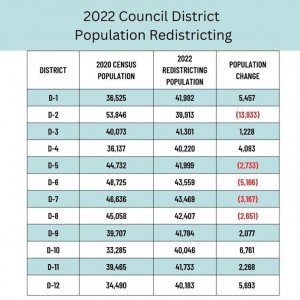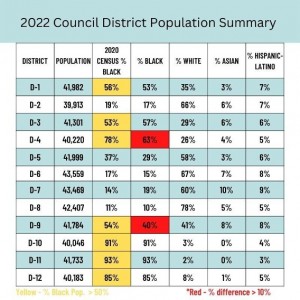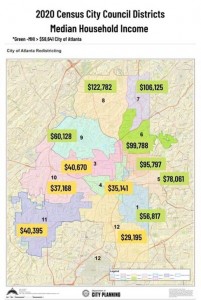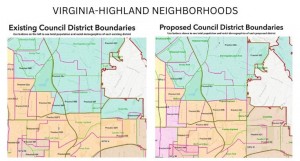Atlanta Redistricting Produces More White Majority Districts
 Images by Adrian Paulette Coleman, Atlanta Progressive News; graphics by Department of Planning published pursuant to fair use doctrine; two graphics by Department of Planning with superimposed data by Adrian Paulette Coleman.
Images by Adrian Paulette Coleman, Atlanta Progressive News; graphics by Department of Planning published pursuant to fair use doctrine; two graphics by Department of Planning with superimposed data by Adrian Paulette Coleman.
(APN) ATLANTA – On October 17, 2022, in a unanimous vote of thirteen to zero, the City Council of Atlanta adopted City of Atlanta Ordinance 22-O-1700 to change the boundaries of the twelve Council Districts in a charter amendment to redistrict the City’s population following the 2020 U.S. Census.
Councilwoman Mary Norwood (District 8) was away, and Alex Wan (District 6) was absent.
Previously, the Full Council, in an eleven to two vote, approved the same maps on “second read” during the October 03, 2022 Full Council meeting. (Charter amendments, such as this ordinance, require three readings.)
In that prior vote Councilmembers Byron Amos (District 3) and Jason Dozier (District 4) voted no. Dozier’s District, District 4, was most substantially carved up and dismantled.
It is not immediately clear what caused Councilmembers Amos and Dozier to change their votes, given that there are no changes to the maps.
Councilmembers Howard Shook (District 8) and Dustin Hillis (District 9) were absent from the October 03 vote.
The new Council District boundaries will take effect at Atlanta’s next general Municipal Election in 2025.
Council’s 2022 redistricting significantly changes district boundaries, splits legislative representation of established neighborhoods, decreases the number of council districts with a majority-minority population, and may dilute the Black vote in future Municipal Elections.
During the time that the ordinance was being considered, when one walked into Atlanta City Hall’s atrium, a lone map stood, depicting the Council’s then-proposed redistricting.
The map’s pastel colors, highlighting proposed Council district boundaries, masked complex truths about race, class, density, and the future of the City of Atlanta.
Atlanta’s Code of Ordinances Section 5-202, paragraph b states: “The council shall reapportion the council districts in accordance with the following specifications:
“1. Each reapportioned district shall be formed of contiguous territory, and the boundary lines of said district shall be the center lines of streets or other well-defined boundaries;
“2. Variation in population between such districts shall comply with the one-person-one-vote requirements of the United States Constitution; and
“3. The reapportionment shall be limited to adjusting the boundary lines of the existing districts only to the extent reasonably necessary to comply with the requirements of paragraph (2) above; and the number of members of the council and the manner of electing such members, except for the adjustment of district boundary lines, shall not be changed by the council.”
2020 CENSUS: ATLANTA’S POPULATION CHANGES
 The U.S. Census Bureau published the 2020 Decennial Census in September 2021, showing disproportionate population growth across Atlanta’s twelve City Council districts.
The U.S. Census Bureau published the 2020 Decennial Census in September 2021, showing disproportionate population growth across Atlanta’s twelve City Council districts.
The data showed significant population growth in northeast Council Districts, and stagnant growth or reduction in population in Atlanta’s southern and southwest districts.
According to the 2020 decennial census, downtown’s District 2, represented by Councilmember Amir Farokhi, has the highest population; 53,846 residents, an increase of 17,220 residents from 2011’s Council redistricting population of 36,626 residents.
District 10, represented by Councilmember Andrea Boone, has the lowest population, 33,285 residents, a loss of 46 residents from 2011’s Council redistricting population of 33,331 residents.
REDISTRICTING OF CITY COUNCIL DISTRICTS
 The goal of redistricting is to reapportion or distribute Atlanta’s population more evenly across twelve City Council districts.
The goal of redistricting is to reapportion or distribute Atlanta’s population more evenly across twelve City Council districts.
A target or average district population is calculated as Atlanta’s total population (498,715) divided by the number of districts (twelve), or 41,560 residents per district. Thus, each district population should fall within a range of 39,482 and 43,638 residents.
Accordingly, the geographical boundaries of Council Districts with a population greater than 41,560, for example, District 2, needed to shrink to reduce the population size.
Conversely, the boundaries of districts with fewer than 41,560 residents, for example, District 10, needed to expand to increase the district’s population.
THE IMPACT OF GROWTH AND DENSITY
Many factors can contribute to variances in a City Council District’s population size, but one key factor is density, and it is a simple math problem.
Housing structures in southwest Atlanta are largely single family homes; and the population growth in southwest Council districts cannot compete with the pace of vertical housing construction in Atlanta’s northeastern districts, where the sky is the limit.
According to 2020 Census data, Atlanta City Council District 2 has more housing units (37,581 units) than District 10 (15,267 units) and District 11 (18,488) combined.
 54 percent of housing structures in District 2 have 50+ units. In District 10, 58 percent of housing structures are 1 unit detached, and only five percent of housing structures are 50+ units.
54 percent of housing structures in District 2 have 50+ units. In District 10, 58 percent of housing structures are 1 unit detached, and only five percent of housing structures are 50+ units.
CHANGING RACIAL DEMOGRAPHICS
U.S. Census Bureau’s 2020 population data show seven of Atlanta’s City Council Districts, based on existing boundaries, where the majority of the District’s population is Black: Districts 1, 3, 4, 9, 10, 11, and 12.
 However, City Council’s 2022 redistricting boundaries eliminate District 9 as a majority-minority district, reducing the number of majority-minority districts from seven to six. The 2022 redistricting also reduces the percentage of Black residents in District 4 by fifteen percentage points, by pulling the northeast boundaries of District 4 upward toward Atlanta’s growing downtown.
However, City Council’s 2022 redistricting boundaries eliminate District 9 as a majority-minority district, reducing the number of majority-minority districts from seven to six. The 2022 redistricting also reduces the percentage of Black residents in District 4 by fifteen percentage points, by pulling the northeast boundaries of District 4 upward toward Atlanta’s growing downtown.
https://www.atlantaga.gov/home/showpublisheddocument/56735/637994606070900000
Notably, on March 10, 2022, the U.S. Census Bureau issued findings that the 2020 Census overcounted White, non-Hispanic alone and Asian populations, and undercounted Black/African-American, Hispanic, and Native American populations.
THE NEW ATLANTA IS RACIALLY SEGREGATED
 Atlanta City Council’s redistricting also shows how Atlanta is increasingly segregated by race. The majority of Atlanta’s Black residents live in western and southern City Council districts.
Atlanta City Council’s redistricting also shows how Atlanta is increasingly segregated by race. The majority of Atlanta’s Black residents live in western and southern City Council districts.
Historical comparison of City Council population summary reports shows the percentage of Atlanta’ Black residents decreasing in central and eastern Council districts.
 For example, Atlanta City Council’s 2001 population summary shows the population of District 5 was 78 percent Black. The 2022 population summary shows the population of District 5 decreases to 29 percent Black.
For example, Atlanta City Council’s 2001 population summary shows the population of District 5 was 78 percent Black. The 2022 population summary shows the population of District 5 decreases to 29 percent Black.
The 2020 Census also shows wide variances in median household income across Atlanta’s City Council Districts, with Atlanta’s poorest residents concentrated in districts 4, 10, 11, and 12, each with a percentage of households below the poverty line that is 25 percent or higher.
 City Council District 8, represented by Councilwoman Mary Norwood, has the highest median household income: 122,782 dollars.
City Council District 8, represented by Councilwoman Mary Norwood, has the highest median household income: 122,782 dollars.
City Council District 12, represented by Councilmember Antonio Lewis, has the lowest median household income: 29,195 dollars.
REDISTRICTING PROCESS LACKING IN TRANSPARENCY
A delegation of the Atlanta Planning Advisory Board (APAB) attended Atlanta’s Committee On Council’s September 19, 2022 meeting to appeal for public engagement in the redistricting process.
Lora Hawk, APAB Corresponding Secretary, read a letter sent on behalf of APAB’s leadership to Councilmember Andrea Boone (District 10), Chair Committee on Council, which reads in part:
“On February 7, 2022, the Atlanta City Council adopted Resolution 22-R-3135 expressing the council’s intent to start the redistricting process of amending council district boundaries as a result of the 2020 decennial census,” Hawk read.
“The adopted resolution included a redistricting calendar listing a series of planned actions including a public information session, work sessions and a public hearing that would occur prior to the introduction of the redistricting charter amendment…” Hawk read.
“At the regularly scheduled Council meeting on September 6, 2022, you introduced the redistricting amendment, charter ordinance 21-O-1700, as a personal paper for first reading. To date, the Council has not held any public information sessions, work sessions or public hearings where the citizens of Atlanta could learn more about the redistricting process or provide input on proposed plans,” she said.
“APAB advises the Atlanta city council at a minimum to hold two public hearings on redistricting of council districts as described in the previously adopted redistricting calendar,” she said.
Then, the Atlanta City Council scheduled and held two redistricting public hearings, both on September 29, 2022.
 “What was the priority of keeping neighborhoods together as you did the redistricting, and how many neighborhoods ended up split apart?” Kay Stevenson, Virginia-Highland resident, asked in the noon hearing.
“What was the priority of keeping neighborhoods together as you did the redistricting, and how many neighborhoods ended up split apart?” Kay Stevenson, Virginia-Highland resident, asked in the noon hearing.
“In Virginia-Highland, I’ve lived there over 25 years and we have always been in District 6. Going forward, it appears we’re going to be in District 6, District 2, and District 5,” Stevenson said.
“It’s not that I have anything against the other council people, but it makes it very difficult for us to get things done and to work with the council when we have three different Council representatives that we have to work with,” Stevenson said.
“I’m a little sad that this input is coming at the end of the process because I feel like this is a done deal. And we might have ended up in a different place if we had had some public input earlier in the process,” she said.
Councilmembers did not respond to Stevenson’s questions or comments.
PRECLEARANCE NO LONGER NEEDED
In 2013, the Supreme Court of the U.S. ruled in Shelby County v. Holder that the coverage formula in Section 5 preclearance requirement of the Voting Rights Act–which previously required preclearance of changes to voting laws in certain jurisdictions–is unconstitutional.
https://www.supremecourt.gov/opinions/12pdf/12-96_6k47.pdf
As a result of the Supreme Court’s ruling, unlike in 2011, City of Atlanta no longer needs U.S. Department of Justice’s preclearance for Council District redistricting.
In 2011, Atlanta City Council–under the leadership of then COC Chair Felicia A. Moore (District 9)–held multiple public redistricting meetings including a redistricting lunch & learn, held a public information session, reviewed redistricting principles, discussed Atlanta City Council methods, publicly reviewed proposed multiple plans and six maps, and held two work sessions and a public hearing BEFORE first read of Charter amendment by full Council.
https://atlantaprogressivenews.com/2011/09/17/atlanta-council-to-redistrict-for-midtown-buckhead-growth/
https://atlantaprogressivenews.com/2012/01/03/atlantas-redistricting-maps-changed-again-map-6-preserves-grady-in-midtown/
By contrast, this year, in 2022, the Atlanta City Council publicly shared one map and held two public hearings AFTER the City Council’s first read of Charter amendment by Full Council, and only following a request for greater transparency and public engagement from APAB.
Just because the additional transparency is not required by the USDOJ did not preclude providing that level of transparency to the public.
(END / Copyright Atlanta Progressive News / 2022)
This is very good information. It is a shame that people will not do the right thing when no one is looking. We need redistricting reform at the state level along with affordable housing. This is why we continue to see these patterns 55 years after the civil right and voting rights acts